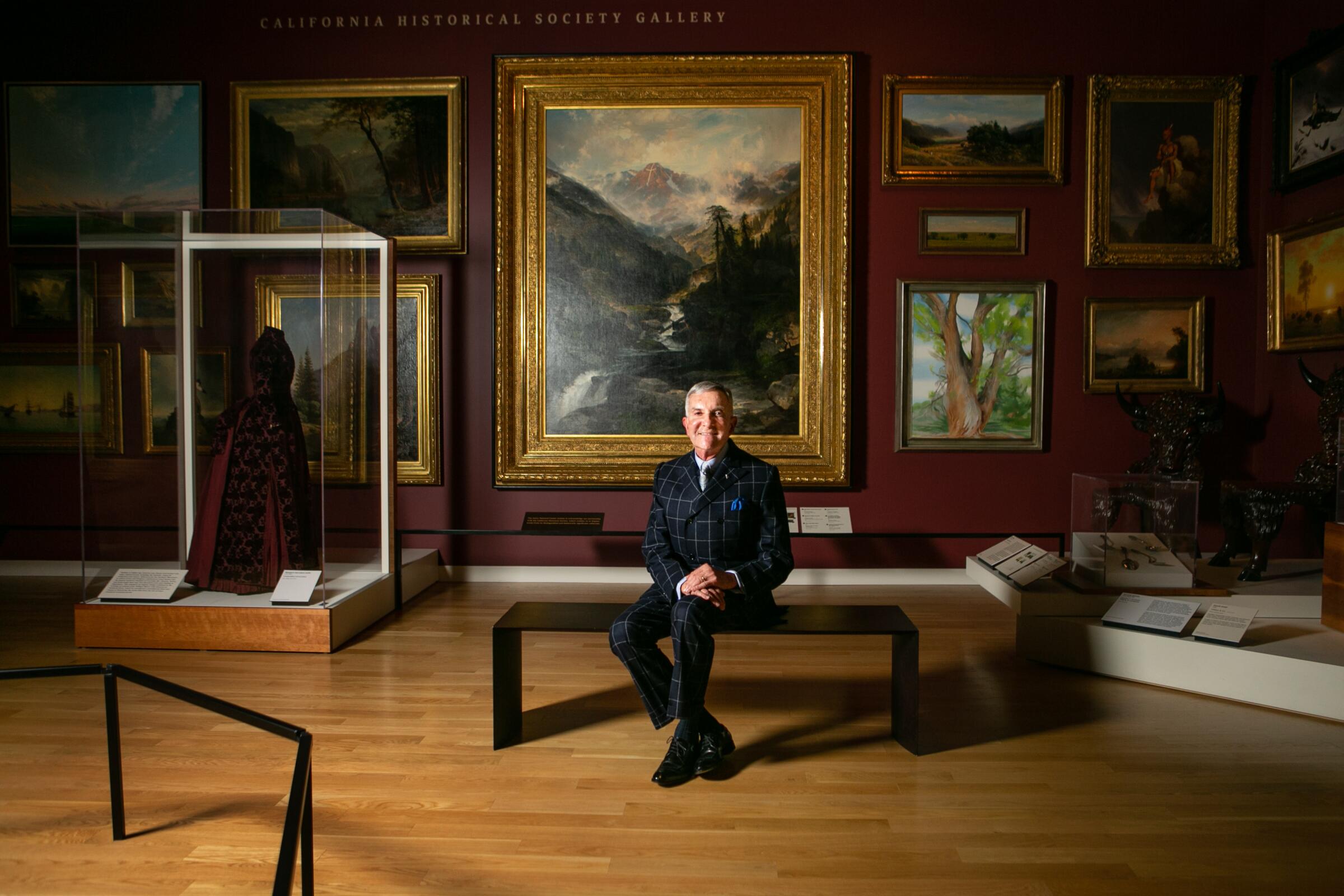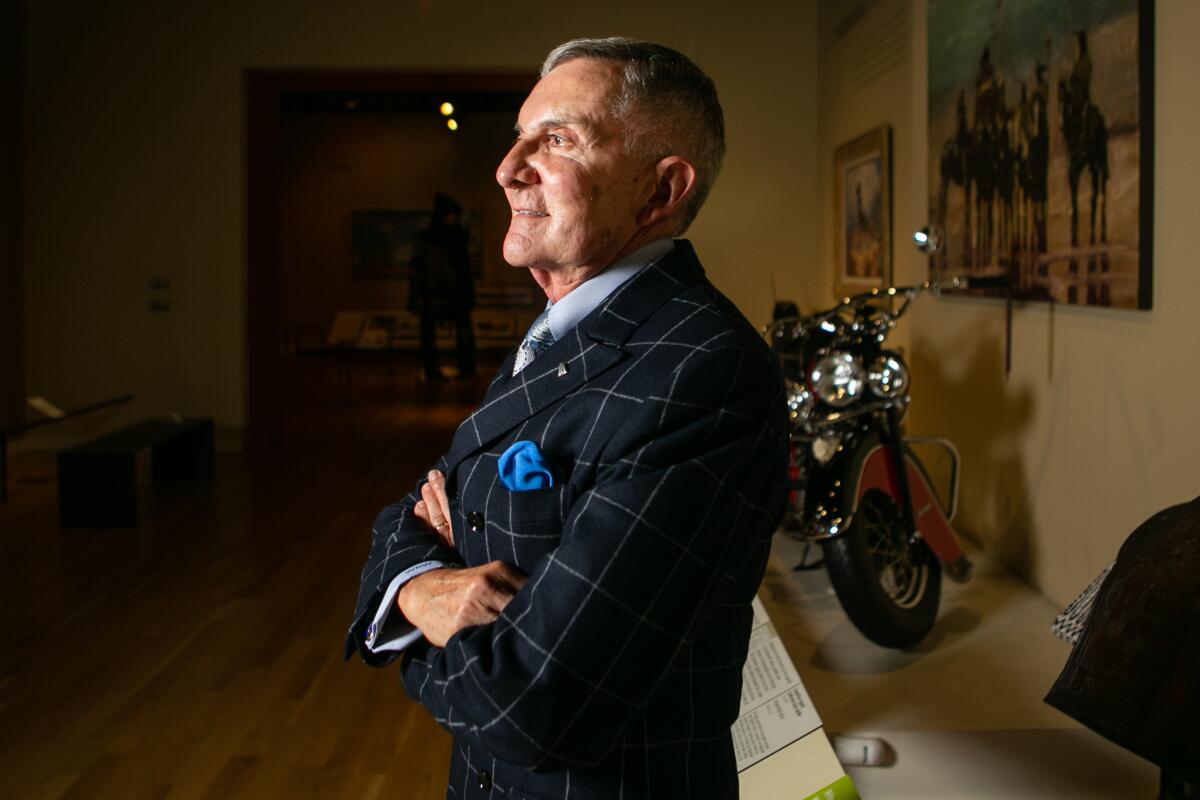The biggest entertainment stories
Get our big stories about Hollywood, film, television, music, arts, culture and more right in your inbox as soon as they publish.
You may occasionally receive promotional content from the Los Angeles Times.

When Gene Autry’s Western Heritage Museum opened in November 1988, its exhibitions included a collection of Colt firearms, a saddle that belonged to Buffalo Bill Cody and works by Western landscape painters including Albert Bierstadt and Thomas Moran. One of the galleries was named “Spirit of Conquest.”
A lot has changed at the Autry, now known as the Autry Museum of the American West.
A logbook digitized by the Autry Museum reveals tribal activists and celebrities who came to Alcatraz during a 19-month occupation that began in 1969.
In 2003, the museum merged with the Southwest Museum of the American Indian, giving the institution one of the great collections of Indigenous artifacts in the U.S. Over the ensuing years, the Autry has continued to expand the themes it addresses. This includes exhibitions devoted to important contemporary Indigenous artists such as Rick Bartow and Harry Fonseca as well as a 2018 show that explored the archives of the Chicano activist newspaper “La Raza,” organized in collaboration with UCLA’s Chicano Studies Research Center.
Overseeing some of those changes has been the museum’s president and CEO, W. Richard West, Jr., 78, who has led the Autry for close to a decade.
“In fairness to the Autry, it was happening before I got here,” he says of the museum’s evolution. “Gene and Jackie [Autry’s] conception of the museum was far beyond a cowboy museum. ... I have tried along with others, the staff and the board of trustees, to make that stamp of diversity more structural and more prominent.”
Now West, who often goes by the more informal Rick West, is set to retire Wednesday — marking another moment of transition. (Succeeding him will be Stephen Aron, a UCLA historian who has long been involved with the Autry.)
A citizen of the Cheyenne and Arapaho Tribes, West was born in San Bernardino, raised in Oklahoma and initially worked as a lawyer. But in his 40s, he made the shift to museums, becoming the founding director of the Smithsonian’s National Museum of the American Indian in Washington, D.C. in 1990. (He was there until 2007.)
He joined the Autry at the tail end of 2012 and in his time there has been instrumental in hiring curators such as Joe D. Horse Capture and Tyree Boyd-Pates, known for their community-minded methods of curation. He has also seen to fruition the construction of a 100,000-square-foot resources center in Burbank that will not only serve as an important site of collections care and study but function as a space in which members of Indigenous communities can stage ceremonies. (It is scheduled to open to the public next year.)
In this conversation, edited for length and clarity, West took time out of his frantic final days at the Autry to chat about what’s changed in the relationship between Native Americans and museums, why he wanted dirt floors in one of the NMAI’s buildings, and how his artist father helped shape his view of art.
It’s the people — connection with staff and with audiences that I have really missed. It’s ironic; in some ways the pandemic expanded the footprint of the museum. We had to switch so quickly to programming that was online, virtual programming. But there is an element of museum work that is very much social. I’ve missed that.
What defines the Autry in the most important way is something that most people would not identify with us and that’s Native Voices, the theater program. It speaks right at you. It articulates a Native presence, not just as some ethnographic presence. With objects, you have more difficulty doing that. It’s more undeniable if you walk into a play; that is a more contemporary experience.
Native Voices existed before I got there. [It was founded in 1994.] When I was director at the NMAI, I tried to get it to the NMAI and I talked to founders Randy Reinholz and Jean Bruce Scott, and they were like, “We think we will stay put.” The story is that I followed them out here since they refused to follow me!
The other thing is the resources center. That is so important because it aligns so closely with a collaborative relationship with the Native community here in California. And that is where we upset the apple cart perhaps most profoundly in our approach to presentation. It took what is normally considered off limits to most of the public — this place that scholars go to study objects — and we’re making it an integral programmatic component.
This is precisely my point. I remember the first time I visited the collection that became the foundation of the collection of the NMAI, the Heye Foundation collection. I was a kid. My father took us to see [it] in New York. We went to the collections that held Plains materials and there was a heavy dose of Cheyenne material. I’d never seen anything like it. The question I asked my dad was, “What is this all doing here?”
Native people were not welcome in museums. My father was an artist who knew someone, so we got into see it. But seeing Native material in a museum is inherently a false experience. We never put things on walls. Every object you see is associated with life and living in a Native community. You can never make a genuine gallery space in that way.
The Autry Museum of the American West leader, a champion of contemporary Native art, is credited with transforming the institution.
But you can do the following: make sure that you have Native voices sitting close to that material and its interpretation. There is the issue of repatriation, in which, under federal law, certain objects are returned. And the second one is that you develop a collaborative relationship with Native communities. That is something that we are working on right now with a tribe here in California, where we will strike up a lending relationship. Portions of our collection will go to their museum on a long-term loan.
Those types of things are undoing that love/hate relationship. But it has to be through a kind of mutual engagement and respect.
It plays out in the architecture through the creation of a certain set of spaces — and it’s true of the cultural resources center at the NMAI and the resources center of the Autry. Both of those spaces accommodate living cultures, not dead cultures. That’s why at both places there are ceremonial gathering spaces and those are limited to the Native constituents of the museums. There is a ceremonial garden at the Autry’s Resources Center; there is a green room. If people are arriving [for a ceremony], they can go from the green room into the garden.
It goes all the way from the architecture to the materials that you select. At the NMAI, the ground plain of the ceremonial area led through its own double door directly outside. I wanted the floor to be dirt, but people had near strokes! [Laughs.] So we made it wood. That’s the same thing we did out here. It also has to do with the presence of certain types of plants. The effort is to make it appropriate to the maintenance and sustaining of culture rather than simply academic inquiry. For Native people, we treat those objects as living.
Honestly, what happens at the resources centers of the NMAI and the Autry is more innovative and revolutionary than things we do on the gallery floors.
Everyone thinks there is no connection, but there is! I went to Stanford, and it was a very intentional act. For me, becoming a lawyer, and becoming a Native rights lawyer, brought me to the barricades I was interested in. I then went to a private law firm in Washington, D.C., that at the time had the largest American Indian practice in the country. I was in court on behalf of tribes — state courts, federal courts, other courts — and there was a great opportunity for legal reform that spoke directly to protecting the legal autonomy of Indian tribes.

So the first half of my career was trying to protect those legal prerogatives. But I wanted to protect the future of Native tribes in their capacities to have cultural self-governance. That led me to the NMAI. I saw museums as institutions that could be proactive in protecting the capacity of Native communities to have cultural continuance in addition to the legal and constitutional rights.
It did not hurt that I happened to be the child of two artists: My mom was a musician — she was not Native — but my dad was a Native painter.
When my dad, [Walter Richard West Sr., whose Cheyenne name was Wah-pah-nah-yah], began painting it was during an era when painting — hide painting — it was an act of preservation. Things were recorded; they were put down. He went on to become a recognized artist. He was fascinated by the engagement between traditional Plains painting on the one hand and European Modernism on the other. I learned a great deal from his painting.
I remember a trip to the Philbrook Museum of Art in Oklahoma. He showed me this Northwest Coast object — I think it was a bowl. So he went about describing it from an art standpoint and what made it beautiful: line, material and composition. Then he said, “But that’s not what it really means.” And he talked about its meaning as a ceremonial object, as something alive and living. His views had everything to do with how I look at museums.
The first book is by a Native author and it’s nonfiction — about Native values in a contemporary world: “Braiding Sweetgrass,” and it’s by Robin Wall Kimmerer. Another one is “Sapiens: A Brief History of Humankind,” by Yuval Harari. But I would, quite frankly, like to have more time with my grandkids. And I would love to write more. My contribution to scholarship has been in institution building and speeches.
I love to travel, and I would like to do more of that while I’m still able. We are going to Italy in October, southern Italy. I love Italy. And my wife, Mary Beth [West] and I, we both love Bali. I think about walking across rice paddy fields in Indonesia. It’s poetry in nature. It’s a cultivated, curated, physical atmosphere in one way, and yet it’s not. It’s a combination of human experience and nature — and not one in which you think nature has been necessarily robbed.
The biggest entertainment stories
Get our big stories about Hollywood, film, television, music, arts, culture and more right in your inbox as soon as they publish.
You may occasionally receive promotional content from the Los Angeles Times.